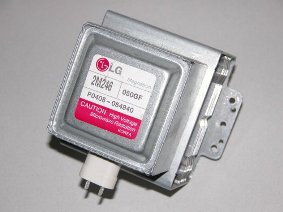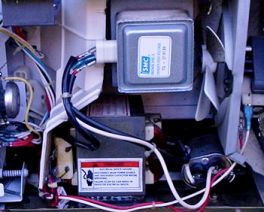How the magnetron works and works
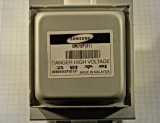 Magnetron - a special electronic device in which the generation of ultra-high-frequency oscillations (microwave oscillations) is carried out by modulating the electron flow in terms of speed. Magnetrons have greatly expanded the field of application of heating with high and ultra-high frequency currents.
Magnetron - a special electronic device in which the generation of ultra-high-frequency oscillations (microwave oscillations) is carried out by modulating the electron flow in terms of speed. Magnetrons have greatly expanded the field of application of heating with high and ultra-high frequency currents.
Amplitrons (platinotrons), klystrons and traveling wave lamps based on the same principle are less common.
The magnetron is the most advanced generator of high power microwave frequencies. It is a well evacuated lamp with an electron beam controlled by an electric and magnetic field. They make it possible to obtain very short waves (up to fractions of a centimeter) at significant powers.
Magnetrons use the movement of electrons in mutually perpendicular electric and magnetic fields created in the annular gap between the cathode and anode. An anodic voltage is applied between the electrodes, creating a radial electric field under the influence of which the electrons removed from the heated cathode rush to the anode.
The anode block is placed between the poles of an electromagnet, which creates a magnetic field in the annular gap directed along the axis of the magnetron. Under the influence of a magnetic field, the electron deviates from the radial direction and moves along a complex spiral trajectory. In the space between the cathode and the anode, a rotating electron cloud with tongues is formed, reminiscent of the hub of a wheel with spokes. Flying past the slots of the anode cavity resonators, the electrons excite high-frequency oscillations in them.
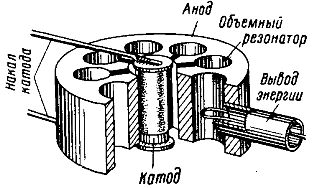
Rice. 1. Magnetron anode block
Each of the cavity resonators is an oscillatory system with distributed parameters. The electric field is concentrated in the slots and the magnetic field is concentrated inside the cavity.
The output energy from the magnetron is realized by means of an inductive loop placed in one or more often two adjacent resonators. The coaxial cable supplies power to the load.
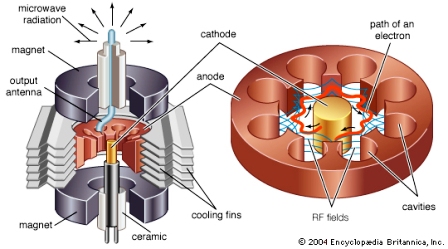
Rice. 2. Magnetron device
Heating with microwave currents is carried out in waveguides with a circular or rectangular cross-section or in volume resonators in which electromagnetic waves the simplest forms TE10 (H10) (in waveguides) or TE101 (in cavity resonators). Heating can also be done by emitting an electromagnetic wave to the heating object.
Magnetrons are powered by rectified current with a simplified rectifier circuit. Very low power units can be AC powered.
Magnetrons can operate at different frequencies from 0.5 to 100 GHz, with powers from a few W to tens of kW in continuous mode and from 10 W to 5 MW in pulsed mode with pulse durations mainly from fractions to tens of microseconds.
Rice. 2. Magnetron in a microwave oven
The simplicity of the device and the relatively low cost of magnetrons, combined with high intensity of heating and diverse applications of microwave currents, open great prospects for their use in various fields of industry, agriculture (for example, in dielectric heating installations) and at home (microwave oven).
Magnetron operation
So it's the magnetron electric lamp a special design used to generate ultra-high-frequency oscillations (in the range of decimeter and centimeter waves). Its characteristic is the use of a constant magnetic field (to create the necessary paths for the movement of electrons inside the lamp), from which the magnetron got its name.
The multi-chamber magnetron, the idea of which was first proposed by M. A. Bonch-Bruevich and realized by the Soviet engineers D. E. Malyarov and N. F. Alekseev, is a combination of an electron tube with volume resonators. There are several of these cavity resonators in a magnetron, which is why this type is called multi-chamber or multi-cavity.
The principle of design and operation of a multi-chamber magnetron is as follows. The anode of the device is a massive hollow cylinder, in the inner surface of which a number of cavities with holes are made (these cavities are volume resonators), the cathode is located along the axis of the cylinder.
The magnetron is placed in a permanent magnetic field directed along the axis of the cylinder. Electrons escaping from the cathode on the side of this magnetic field are affected by Lorentz force, which bends the path of electrons.
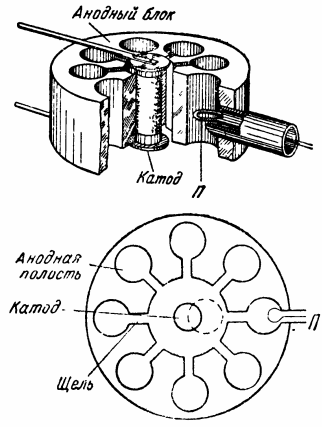
The magnetic field is chosen so that most of the electrons move along curved paths that do not touch the anode. If the device cameras (cavity resonators) appear electrical vibrations (small fluctuations in volumes always occur for various reasons, for example, as a result of turning on the anode voltage), then an alternating electric field exists not only inside the chambers, but also outside, near the holes (slots).
Electrons flying near the anode fall into these fields and, depending on the direction of the field, either accelerate or decelerate in them. When electrons are accelerated by a field, they take energy from the resonators, on the contrary, when they are decelerated, they give up some of their energy to the resonators.
If the number of accelerated and decelerated electrons were the same, then on average they would not give energy to the resonators. But the electrons, which are slowed down, then have a lower speed than what they get when moving to the anode. Therefore, they no longer have enough energy to return to the cathode.
On the contrary, those electrons that were accelerated by the resonator field then possess energy greater than that required to return to the cathode. Therefore, electrons that, entering the field of the first resonator, are accelerated in it, will return to the cathode, and those that are slowed down in it will not return to the cathode, but will move along curved paths near the anode and fall into the field of the following resonators.
At a suitable speed of movement (which is somehow related to the frequency of oscillations in the resonators), these electrons will fall into the field of the second resonator with the same phase of oscillations in it as in the field of the first resonator, therefore, in the field of the second resonator , they will also slow down.
Thus, with a suitable choice of electron velocity, i.e.anode voltage (as well as the magnetic field, which does not change the speed of the electron, but changes its direction), it is possible to achieve such a situation that an individual electron will either be accelerated by the field of only one resonator, or decelerated by the field of several resonators.
Therefore, the electrons will, on average, give more energy to the resonators than they will take away from them, that is, the oscillations that occur in the resonators will increase and, eventually, oscillations of constant amplitude will be established in them.
The process of maintaining oscillations in resonators, considered by us in a simplified way, is accompanied by another important phenomenon, since electrons, in order to be slowed down by the field of the resonator, must fly into this field at a certain phase of oscillation of the resonator, obviously is that they must move in a non-uniform flow (t. then they would enter the resonator field at any time, not at certain times, but in the form of individual bundles.
For this, the entire stream of electrons must be like a star, in which the electrons move inside in separate beams, and the whole star as a whole rotates around the axis of the magnetron at such a speed that its beams come into each chamber at the right moments. The process of formation of separate beams in the electron beam is called phase focusing and is carried out automatically under the action of the variable field of the resonators.
Modern magnetrons are capable of creating vibrations up to the highest frequencies in the centimeter range (waves up to 1 cm and even shorter) and delivering power up to several hundred watts with continuous radiation and several hundred kilowatts with pulsed radiation.
See also:Examples of the use of permanent magnets in electrical engineering and energy

